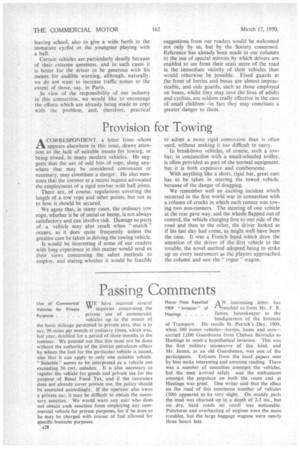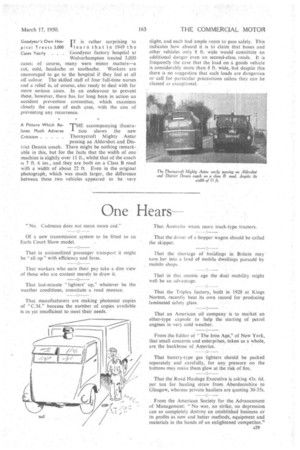Passing Comments
Page 30

Page 31

If you've noticed an error in this article please click here to report it so we can fix it.
WE have received several " inquiries concerning the private use of commercial vehicles up to the extent of the basic mileage permitted to private cars, that is to say, 90 miles per month at ordinary times, which was, last year, doubled for a period of three months in the summer. We pointed out that this must not be done without the authority of the district petroleum officer by whom the fuel for the particular vehicle is issued, also that it can apply to only one suitable vehicle. "Suitable" seems to be interpreted as a vehicle not exceeding 30 cwt. unladen. It is also necessary to register the vehicle for goods and private use for the purpose of Road Fund Tax, and if the insurance does not already cover private use, the policy should be amended accordingly. If the operator also owns a private car, it may be difficult to obtain the necessary sanction. We would warn any user who does not obtain such sanction from employing any commercial vehicle for private purposes, for if he does so he may be charged with misuse of fuel allowed for specific business purposes.
A28
Use of Commercial Vehicles for Private Purposes
Motor Fleet Repelled A N interesting letter has 1909 " Invasion " of i—lreached us from Mr. F. R.
Hastings James, housekeeper to the
headquarters of the Institute of Transport. He recalls St. Patrick's Day, 1909, when 300 motor vehicles—lorries, buses and cars— carried 1,000 Guardsmen from Chelsea Barracks to Hastings to repel a hypothetical invasion. This was the first military manceuvre of this kind, and Mr. James, as an old Guardsman, was one of the participants. Extracts from the local papers sent by him make interesting and amusing reading. There was a number of casualties amongst the vehicles. but the men arrived safely and the enthusiasm amongst the populace on both the route and at Hastings was great. One writer said that the effect on the road of this enormous number of vehicles (300) appeared to be very slight. On muddy parts the mud was churned up to a depth of 2-3 ins., but on dry, hard roads no result was noticeable. Punctures and overheating of engines were the main troubles, but the large baggage wagons were nearly three hours late.
IT is rather surprising to 'learn that in 1949 the Goodyear factory hospital at Wolverhampton treated 3,000 cases; of course, many were minor, matters—a cut, cold, headache or toothache. Workers are encouraged to go to the hospital if they feel at all off colour. The skilled staff of four full-time nurses and a relief is, of course, also ready to deal with far more serious cases. In an endeavour to prevent these, however, there has for long been in action an accident prevention committee, which examines closely the cause of each case, with the aim of preventing any recurrence.
Goodyear's Own Hosp i ta I Treats 3,000 Cases Yearly ,
A Picture Which ReTHE accompanying illustra futes Much Adverse tion shows the new Criticism Thornycroft Mighty Antar
passing an Aldershot. and District Dennis coach: There might be nothing remarkable in this, but for the facts that the width of one machine is slightly over 11 ft., whilst that of the coach IS 7 ft. 6 ins , and they are both on a Class B road with a width of about 22 ft. Even in the original photograph, which was much larger, the difference between these two vehicles appeared to be very
slight, and each had ample room to pass safely. This indicates how absurd it is to claim that buses and other vehicles only .8 ft. wide would constitute an additional danger even on second-class roads. it is frequently the case that the load on a goods vehicle is considerably more than 8 ft. wide, but despite this there is no suggestion that such loads are dangerous or call for particular precautions unless they can be classed as exceptional.




























































































